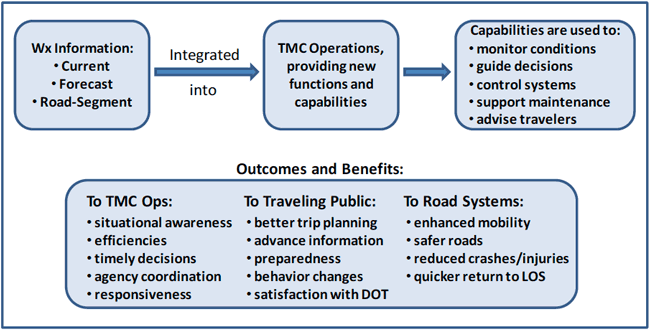Best Practices for Road Weather Management
Kansas City Scout Advanced Traffic Management System
Kansas City Scout (KC Scout) is a comprehensive traffic congestion management and traveler information system conceived, designed, and operated jointly by two Departments of Transportation. In September of 2001, the Missouri Department of Transportation (MoDOT) and the Kansas Department of Transportation (KDOT) jointly announced their bi-state initiative to address traffic impacts on over 100 miles of contiguous freeways intersecting both sides of the state line throughout the greater metropolitan Kansas City area. Kansas City Scout encompasses the jurisdictional boundaries of Cass, Clay and Jackson counties in Missouri and Johnson County and Wyandotte County in Kansas.
Providing the core platform for Scout’s Transportation Management Center (TMC) operation is its state-of-the-art TransSuite™ Advanced Traffic Management System (ATMS). Within this framework, Closed Circuit Televisions (CCTVs), Dynamic Message Signs (DMS) and Vehicle Detection Stations (VDS) are controlled and monitored. Commencing operations in summer 2011, this system integrates weather information with the pre-existing traffic management capabilities of KC Scout. The integrated system was tested during winter 2011 and into the summer months. Evaluation will continue through April 2013 in order to capture data for two complete seasons.
Prior to September 2009, Scout used a UNIX-based system that provided little support for enhancement development, report generation or operator efficiency. Many manual workarounds were developed by Scout staffs that were time consuming to create and maintain but provided the level of utility desired to create and monitor incidents, track activity, and provide management reporting capabilities. Inbound weather information consisted of daily MoDOT radio broadcasts of WeatherOrNot™ furnished forecasts or Internet-based weather media channels monitored on individual desktops. Scout operators became adept at identifying changing weather conditions while constantly monitoring CCTV cameras spanning over 100 miles of interstate in the metro KC area.
With the recent upgrade to ATMS, Scout is able to integrate weather information into the user interface as another “layer” utilizing the data available from external weather information sources, such as National Oceanic and Atmospheric Administration (NOAA), National Weather Service’s (NWS) National Digital Forecast Database (NDFD), and Meridian-511 providers.
System Components: The KC Scout TMC was completed and opened in late 2003. It is an integrated system of 138 CCTVs, 38 DMS, 277 VDS, a highway advisory radio (HAR) system and a dynamic web site offering users the capability of designing their own customized alert messaging profiles. The user-interface utilizes a series of “layers” that visually represent infrastructure (CCTVs, DMS, VDS), traffic incidents, scheduled events (roadwork) and special events (heavy traffic stadium/concert events). The new ATMS software binds the various sensing components, communications infrastructure, weather information, and user interfaces.
System Operations: The Windows/SQL-based TransCore™ product has streamlined all the processes associated with creating and monitoring traffic incidents, activating and updating DMS message boards and linking all pertinent incident information—including weather—into easily accessible databases and reporting tools.
As an example, when a weather condition exists that meets pre-selected alert threshold criteria, a “layer” will “activate” on the operator’s ATMS desktop map application, signaling creation of a weather event type “incident” with applicable DMS messaging and outputs to Scout’s website and subscriber-configured WebAlert applications.
Furthermore, during winter storm events, MoDOT’s traffic department staffs a separate workstation within the TMC, solely for the purpose of monitoring road conditions and reporting on the snowplow activity within its local coverage area. This is of great assistance to KC Scout operations because the information can be used to post DMS messages in advance of the plows, helping to keep those lanes clear of through traffic that would otherwise impede plowing activity.
Transportation Outcome(s): The quickness of being able to notify motorists of a rapidly developing severe weather condition will aid in their decision making and hopefully reduce severe weather related crashes on the interstate. It is expected that this system, with its enhanced and integrated weather information, will result in timelier messaging for the traveling public, along with more proactive internal sharing of weather information between operations and maintenance, and will result in improved highway performance and traveler safety. Figure KC-1 further details benefits from the system.
Figure KC-1. Kansas City Scout’s ATMS integrated with weather information.
Implementation Issues: There are several ongoing concerns for operation and implementation of the system. It is critically important that the integrated ATMS system is fully operational, including functional DMS and CCTVs, for example. Also, operators need to be properly trained in the use of any new components associated with the acquisition, integration, processing and dissemination of weather information.
In regards to the recent software transition, the Windows/SQL-based TransCore™ product deployment was nearly seamless. Training on the use of these new elements required TMC staff development along with support system documentation.
Contact(s):
- Jason Sims, Traffic Center Manager for KC Scout ATMS.
- Nancy Powell, TMC Supervisor, KC Scout.
Reference(s):
- RITA Intelligent Transportation Systems Joint Program Office, February 2011. Weather Information Integration in Transportation Management Center Operations, Final Report, FHWA-JPO-11-058.
Keywords: traffic management, software, transportation management center, road weather information system, customized alerts, Kansas City.
previous | next